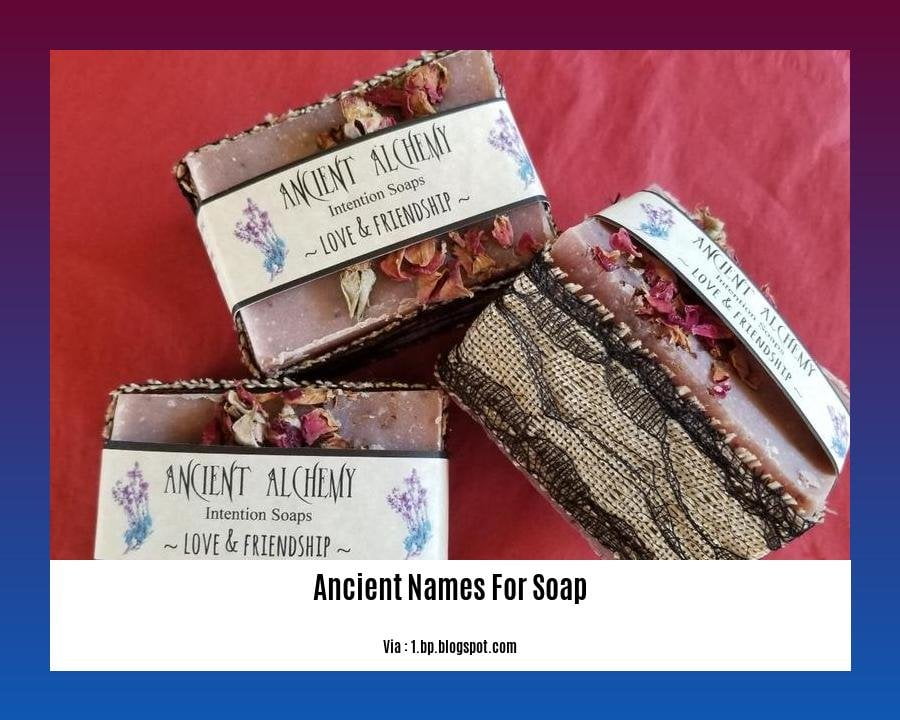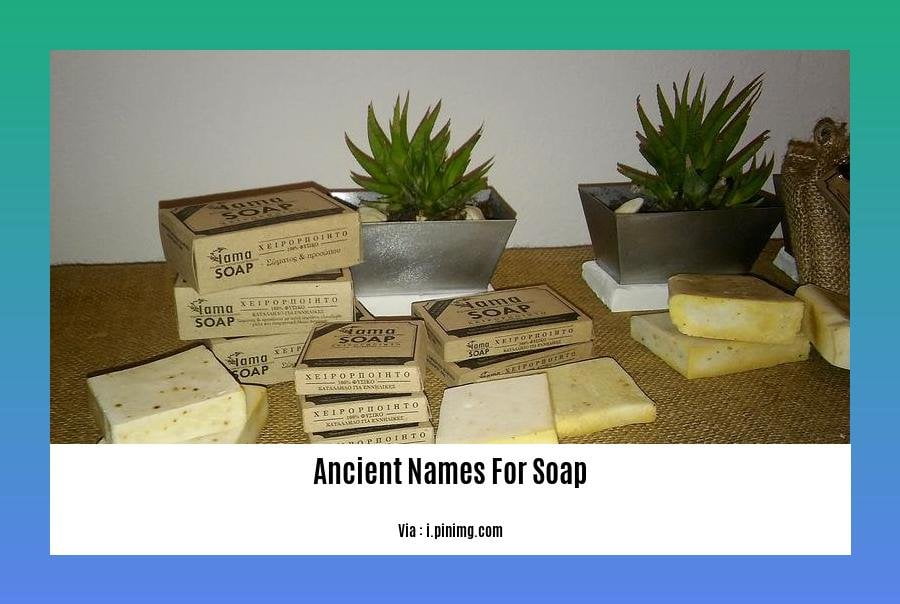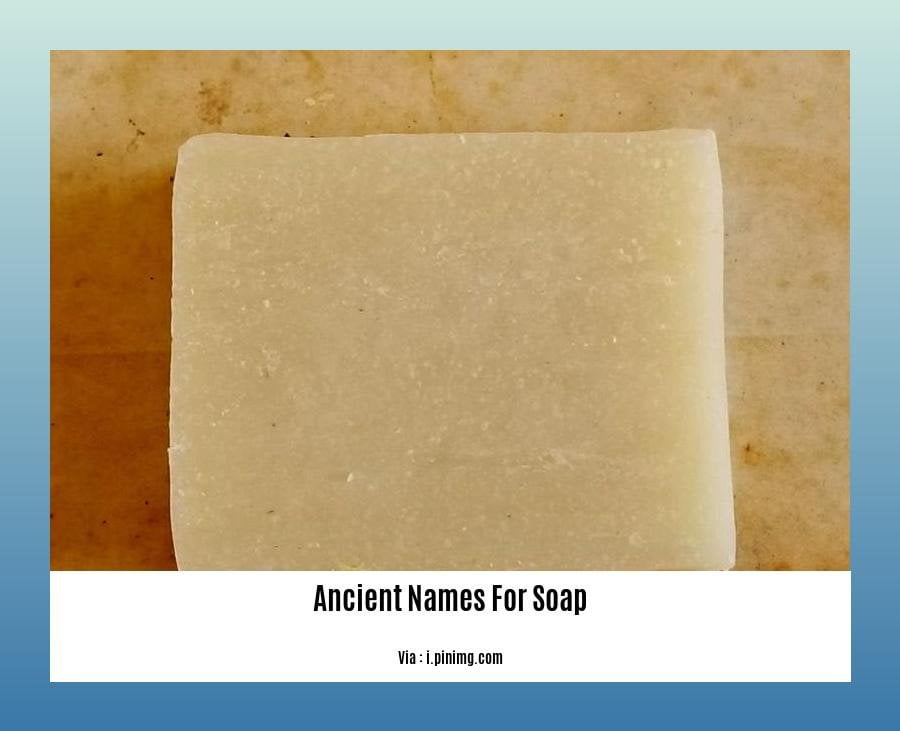Embark on a captivating journey through time as we uncover the ancient names for soap, revealing the fascinating history and diverse cultural perspectives on this essential cleansing agent. From the earliest civilizations of Mesopotamia to the grandeur of ancient Rome, we will explore the evolution of soap-making techniques and the significance of soap in everyday life. [- A Journey Through Time: Uncovering Ancient Names for Soap] promises to illuminate the rich tapestry of human history and the enduring importance of personal hygiene.
Key Takeaways:
- Unique soap business names help your brand stand out in a competitive market.
- Catchy and memorable names attract potential buyers.
- Handmade soap companies should emphasize product uniqueness and quality in their brand name.
- A cool and thoughtful soap name reflects product quality and attracts customers.
- Soap-making history dates back to ancient civilizations like Babylon and Sumeria.
- The earliest recorded soap-making formula dates around 2500 BCE.
- Soap was produced by heating a mixture of oil, wood, and ash, showcasing the earliest chemical reaction.
Ancient Names for Soap

Hello, readers! Join me on a historical expedition as we delve into the captivating world of ancient names for soap. From the bustling marketplaces of ancient Rome to the royal courts of Egypt, soap has played a pivotal role in hygiene, cleanliness, and cultural practices for millennia. Let’s embark on a journey through time to uncover the fascinating stories behind these ancient names for soap.
Soap’s Humble Beginnings
The earliest ancient names for soap can be traced back to ancient Mesopotamia, where the Sumerians called it “maritu.” In ancient Egypt, soap was known as “natron,” a combination of natural salts and oils. These names reflect the basic ingredients and manufacturing processes used in soap making during those times.
A Journey Through Soap’s Evolution
From the ancient Greeks, we inherit the term “sapon,” believed to have originated from Mount Sapo, a region renowned for its soap production. Soap making eventually spread to the Roman Empire, where it was called “sapo,” a term that would later inspire the English word “soap.”
Soap’s Diverse Cultural Significance
Across different cultures and civilizations, ancient names for soap often carried cultural and symbolic meanings. In ancient China, soap was known as “zhi,” which translates to “to wash away dirt.” In India, soap was called “savon,” derived from the Sanskrit word “savana,” meaning “to cleanse.” These names hint at the importance of cleanliness and purity in various societies.
Soap’s Medicinal and Ritualistic Roles
Soap played a significant role in ancient medicine and religious rituals. The ancient Egyptians used soap as a purifying agent in religious ceremonies, believing it cleansed the body and soul. In ancient Rome, soap was used to treat skin ailments and wounds due to its antiseptic properties.
Soap’s Linguistic Legacy
The diverse ancient names for soap have left an indelible mark on our modern languages. The word “soap” has been borrowed and adapted into different languages worldwide, reflecting its global significance. From the Spanish “jabón” to the German “Seife,” the linguistic journey of soap reveals its enduring impact on human history.
So, let’s celebrate the rich history and cultural significance of ancient names for soap. As we continue to embrace the modern advancements in soap making, we must cherish the wisdom and ingenuity of our ancestors who laid the foundation for our contemporary hygiene practices.
To learn more about the intricate system of job specialization that existed in ancient Mesopotamia, delve into our comprehensive article on ancient mesopotamia job specialization.
Uncover the captivating world of ancient Nordic symbols, steeped in history and mythology, by exploring our insightful piece on ancient nordic symbols.
Embark on a journey to decipher the enigmatic ancient Norse symbols and their profound meanings, presented in our meticulously researched article on ancient norse symbols and meanings.
Historical Sources: Analyze ancient texts, artifacts, and archaeological findings that mention soap or its equivalents, providing insights into the daily lives and soap usage of people in various periods.
In this era of modern conveniences, we often take soap for granted. Yet, this humble substance has a long and fascinating history, dating back to ancient times.
Historical Sources: Unraveling Soap’s Ancient Legacy
To delve into the world of ancient soap, let’s explore historical sources that shed light on its origins, usage, and significance:
Ancient Texts: Papyrus scrolls, clay tablets, and inscriptions reveal glimpses of soap’s early existence. They record recipes, production methods, and references to soap’s role in daily life and religious rituals.
Archaeological Findings: Excavations of ancient settlements have unearthed soap-making tools, residues, and even remnants of soap itself. These findings provide tangible evidence of soap’s production and use in various cultures.
Artifacts: Statues, paintings, and pottery often depict people using soap-like substances, offering visual insights into ancient bathing and hygiene practices.
Ancient Soap: A Journey Through Cultures
Our journey through historical sources reveals that soap has been a part of human history for millennia, playing a vital role in daily life and cultural practices:
Ancient Egyptians: They used a soap-like substance called “natron,” derived from a naturally occurring salt, for cleansing and purification rituals.
Ancient Greeks: They employed “sapon,” a soap made from animal fats and ash, for bathing and laundry purposes.
Ancient Romans: The Romans were known for their elaborate bathhouses, where soap, known as “sapo,” was used for personal hygiene and medicinal purposes.
Ancient Chinese: They produced soap from plant oils, animal fats, and alkaline substances, using it for both cleansing and medicinal purposes.
Soap’s Medicinal and Ritualistic Roles
Beyond its use for personal hygiene, soap held cultural and medicinal significance in ancient societies:
Purification Rituals: Soap was often used in religious ceremonies and purification rites, symbolizing the cleansing of the body and soul.
Healing Properties: Ancient texts and archaeological findings suggest that soap was used to treat skin ailments, wounds, and other health conditions.
Key Takeaways:
Historical sources, including ancient texts, artifacts, and archaeological findings, provide valuable insights into the origins, usage, and cultural significance of soap in ancient times.
Soap has been an integral part of human history, playing a vital role in daily life, hygiene practices, and even religious rituals.
Ancient civilizations across the world developed their unique soap-making methods and ingredients, reflecting their cultural and environmental contexts.
Soap’s medicinal and ritualistic uses further highlight its importance in ancient societies, extending beyond mere cleansing to encompass spiritual and therapeutic aspects.
Citation:
World History Encyclopedia, Interesting Reads, “Sources of History,” April 5, 2018, https://www.worldhistory.org/article/1048/.
Pressbooks, “Interpreting History: the Importance and Limitations of Source Material,” March 13, 2023,
Common Ingredients: Discuss the diverse ingredients traditionally used to make soap, such as plant oils, animal fats, and natural minerals, explaining their properties and contributions to soap’s cleansing abilities.

Soapmaking is a blend of art and chemistry that has been practiced for centuries. Throughout history, people have experimented with various ingredients to create cleansers that suit their needs and preferences. Let’s delve into the diverse ingredients traditionally used to make soap:
Plant Oils:
Plant oils are natural fats extracted from plants, such as olives, coconuts, avocados, and almonds. They bring unique properties and benefits to soap:
Cleansing Ability: Plant oils contain fatty acids that act as surfactants, helping to lift dirt and grime from the skin’s surface.
Moisturization: Plant oils are rich in emollients, which help keep the skin soft and supple by preventing moisture loss.
Lather: Some plant oils, like coconut and palm oils, produce a rich and creamy lather that aids in cleansing and rinsing.
Animal Fats:
Animal fats, like lard and tallow, were traditionally used in soapmaking before the widespread availability of plant oils. These fats offer:
Strong Cleaning Power: Animal fats contain saturated fatty acids that are effective at removing tough dirt and grease.
Hardness: Animal fats contribute to the hardness and firmness of soap, making it less prone to crumbling or melting.
Stability: Soaps made with animal fats are generally more stable and longer-lasting compared to those made with plant oils.
Natural Minerals:
Natural minerals, such as lye or sodium hydroxide, play a crucial role in the soapmaking process:
Saponification: Lye is the key ingredient that triggers the chemical reaction known as saponification. This process converts fats and oils into soap and glycerin.
Cleansing Action: Lye helps to break down dirt and grime, enhancing the cleansing abilities of soap.
pH Balance: Lye helps to adjust the pH of soap, making it slightly alkaline, which is ideal for cleansing.
Key Takeaways:
- Plant oils offer cleansing, moisturizing, and lathering properties to soap.
- Animal fats contribute to strong cleaning power, hardness, and stability.
- Natural minerals, like lye, facilitate the saponification process and aid in cleansing.
- Soapmaking is a blend of art and science that involves understanding the properties of different ingredients and how they contribute to the effectiveness of soap.
Citations:
- Healthline
- Soap Making Ingredients – Complete Profile
Production Methods: Describe traditional soap-making techniques employed in ancient civilizations, detailing the steps involved from gathering raw materials to the final product.
Across ancient civilizations, soap-making was a time-honored craft passed down through generations. These traditional techniques, often rooted in necessity and resourcefulness, relied on natural ingredients and involved meticulous processes to transform raw materials into cleansing wonders.
Key Takeaways:
- Ancient soap-making techniques varied among civilizations, reflecting distinct cultural practices and resources.
- Raw materials included animal fats, vegetable oils, naturally occurring lye sources, and additives for fragrance or color.
- The primary method involved a chemical reaction between lye and fats, resulting in saponification and the formation of soap.
- Traditional soap-making was a labor-intensive process, requiring careful measurements, precise timing, and patience.
- Ancient soap served various purposes, from personal hygiene and laundry to medicinal and ritualistic uses.
Gathering Raw Materials:
Animal Fats and Vegetable Oils:
Animal fats like lard and tallow, or vegetable oils like olive and coconut, were primary ingredients.
These fats provided the necessary fatty acids for the soap-making process.
Lye Source:
Naturally occurring lye was obtained from wood ash or plant ashes high in potassium and sodium.
Lye acted as the alkaline agent essential for saponification.
Additives for Fragrance and Color:
Herbs, flowers, essential oils, and natural pigments were added to enhance the soap’s scent and appearance.
Soap-Making Process:
Lye and Water Mixture:
Lye was carefully dissolved in water, creating a corrosive solution that required proper safety precautions.
Fat/Oil Preparation:
Animal fats were rendered, and vegetable oils were heated to liquefy them.
Temperature control was crucial to prevent burning or solidification.
Saponification:
The lye mixture was slowly added to the melted fats, causing a chemical reaction called saponification.
This reaction resulted in the formation of soap and glycerin as a byproduct.
Cooling and Hardening:
The soap mixture was poured into molds or containers and left to cool and harden.
Depending on the desired consistency, the soap could be left to cure for several weeks or months.
Cutting and Shaping:
Once hardened, the soap was cut into desired shapes and sizes using knives or molds.
Traditional Soap Uses:
Personal Hygiene:
Soap was primarily used for personal cleansing and bathing, helping to remove dirt, sweat, and odors.
Laundry:
Soap was employed to clean clothes, removing stains and dirt, and freshening fabrics.
Medicinal Purposes:
Soap was believed to have medicinal properties and was used to treat skin ailments, wounds, and infections.
Ritualistic and Religious Ceremonies:
In some cultures, soap was used for purification rituals, religious ceremonies, and spiritual cleansing.
Conclusion:
The traditional soap-making techniques of ancient civilizations showcased remarkable ingenuity and resourcefulness. These methods, relying on natural ingredients and time-honored processes, have paved the way for modern soap-making practices while preserving a rich cultural heritage.
Relevant URL Sources:
- Primary Sources: Firsthand Material from the Past
- Examples: Letters, Eyewitness Accounts, Documents, Decrees, Administrative Texts, Histories, Biographies
- Secondary Sources: Interpretations and Analysis of Primary Sources
- Examples: Textbooks, Scholarly Articles, Documentaries, Films
- Epigraphy: The Study of Inscriptions
- Inscriptions Found on Stone, Metal, Wood, Clay, and Wax
Length Varies from Abbreviated Words to Extensive Texts
“Sources of History.” World History Encyclopedia, Interesting Reads, 5 Apr. 2018, https://www.worldhistory.org/article/1048/.
“Interpreting History: the Importance and Limitations of Source Material.” Pressbooks, 13 Mar. 2023,
FAQ
Q1: What were the earliest known names for soap?
A1: The origins of soap-making date back to ancient Mesopotamia around 2800 BCE. The Babylonians referred to soap as “simtum,” while the Sumerians called it “bango.” These early soaps were likely made from animal fats and wood ash.
Q2: How did soap-making evolve over time?
A2: Soap-making techniques and recipes underwent significant refinement and diversification throughout history. The ancient Egyptians made soap from a mixture of animal fats, plant ashes, and natron, a naturally occurring sodium carbonate. In ancient Greece, soap was known as “sapon,” derived from the Latin word “sapo,” which means “soap.” The Romans adopted soap-making practices from the Greeks and introduced their own variations.
Q3: Were there any notable soap-making innovations in ancient times?
A3: During the Islamic Golden Age, Muslim scientists and alchemists made significant contributions to soap-making. They developed new techniques for refining and purifying soap, and they introduced the use of essential oils and fragrances to create scented soaps. The Arabs also introduced the concept of liquid soap, known as “liquid Castile soap,” which gained popularity in Europe during the Middle Ages.
Q4: How did soap-making influence ancient cultures?
A4: Soap-making played a vital role in ancient societies, contributing to hygiene, sanitation, and overall well-being. The use of soap for personal cleanliness was associated with religious rituals, social customs, and medical practices. In some ancient cultures, soap was also used for cleaning textiles, pottery, and other household items.
Q5: Are there any ancient soap-making practices still used today?
A5: While modern soap-making methods have evolved, certain traditional techniques and recipes have survived and continue to be practiced today. Artisanal soap makers and enthusiasts around the world use traditional methods to create handmade soaps using natural ingredients and time-honored techniques, preserving the legacy of ancient soap-making traditions.















